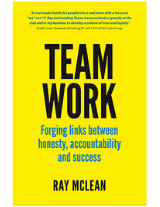High performing teams share a number of characteristics no matter what kind of business they’re working in. Elite individuals in a trusting team challenge each other and work for success in increasingly high-pressure situations. Often, this creates as many challenges as it does opportunities for successes, as highly motivated and driven individuals attempt to put their egos aside in the name of the organisation’s goals.
Competition between these people is inevitable, but it’s wrong to see this as an inherently destructive force. With the right organisational culture, including a focus on behaviour as well as outcomes, competition can be extremely productive – it just needs to be pushing people towards the right goals in support of the organisation’s overall purpose.
What do your goals say about your team?
There’s been plenty said about the nature of rewards people can work towards, but how many managers have thought about the goals that lead people there? If you want people to work together, then solely providing individual goals isn’t going to foster that collaborative spirit. In the worst-case scenario, it’s just going to get people to look out for themselves. Is it possible to incorporate rewards linked to team and behaviour, not just financial targets?
An interview conducted by McKinsey & Company discussed how important the balance is between both joint and individual interests. People in leadership positions have to craft goals and motivational initiatives that balance an individual’s satisfaction with their role and commitment to the greater good of the business or team. This doesn’t mean that individual targets have to be abolished, but tying them to group goals or wider company initiatives can help to ensure everything a person does works towards their and the organisation’s success.
How to understand when goals have to evolve
We worked with an organisation that had a national target here in Australia which was reviewed by its head office in another country. This target cascaded all the way down from a national figure to an individual goal, which sounds fine in theory, but it didn’t reflect the nature of the work the business was doing – static targets for individuals across every state weren’t achievable.
Targets must reflect the overall work the business is doing.
The solution was to follow the work as trends changed. For example, if there was more work in Victoria, those offices got the extra resources and added focus until activity picked up somewhere else. Because the head office was only looking at the final national number, and this fact had been communicated to the whole business, it didn’t matter which state was doing the getting the financial results. As long as the team were able to reach this target together, each individual was successfully playing their part.
To find out more about how to create high performing teams in your organisation, please get in touch today.
Simon started with Leading Teams in 2000 as an athlete facilitator then progressed to a full-time facilitator. He rejoined Leading Teams in 2015. Simon is based in Brisbane.
Learn more about Simon.




